EXPERT
JOINT CARE
CLOSE TO HOME
MAKING HOSPITAL
REGISTRATION
EASIER
MINIMALLY INVASIVE BACK PAIN SOLUTIONS


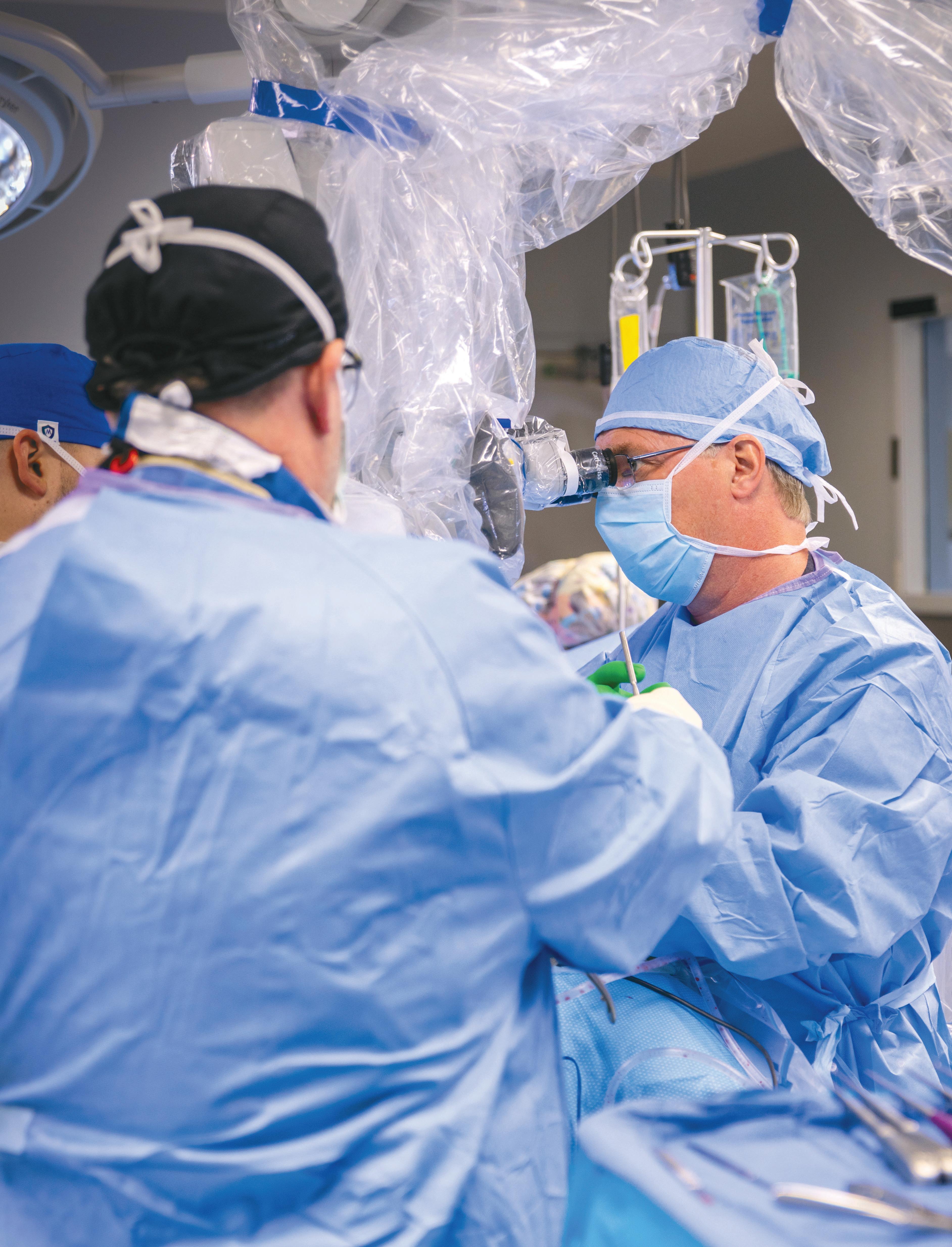

EXPERT
JOINT CARE
CLOSE TO HOME
MAKING HOSPITAL
REGISTRATION
EASIER



The story of pain is as old as the story of humanity. Reliable remedies for pain have long confused and eluded us. But thanks to recent advances in anatomy and neuroscience, this is finally changing. Come hear from our pain physicians as they talk about new therapies that are now available to help you keep moving.
In this session, we will discuss noninvasive and minimally invasive treatments for conditions such as diabetic neuropathy, lumbar spinal stenosis, vertebrogenic back pain, mechanical back pain, postsurgical pain and arthritis of the spine, shoulder and knee. If you’re looking for more, we’ll even take a quick look at the new frontier of regenerative medicine and its applications in musculoskeletal and spine health.
Date: November 8
Time: 5 p.m.
Location: Holyoke Medical Center, Fran Como Conference Room, 575 Beech Street, Holyoke Register at: HolyokeHealth.com/events or call 413.534.2789.
This family-friendly, interactive event will feature free:
• Educational resources for preventing diabetes-related complications
• Blood pressure screening
• Type 2 diabetes risk test questionnaire
• Bilingual recipe book
• Children’s activities including a bounce house
• Raffles and more
Date: November 2
Time: 3 to 6 p.m.
Location: Greater Holyoke YMCA, 171 Pine Street, Holyoke
Managing diabetes is a journey, but not one you have to make alone. Sign up today for a three-part series to discover what you can do to better manage your diabetes. Topics will include:
• Your experience with diabetes
• Monitoring your blood sugar
• Healthy eating and activity
• Long-term management
Dates: November 1, 6 and 15
Time: 5:30 to 7 p.m.
Location: Greater Holyoke YMCA, 171 Pine Street, Holyoke Register at: 413.535.4732
3
4
HEALTHY HABITS News and information for better health.
PATIENT-CENTERED ORTHOPEDIC CARE How a new surgeon and physiatrist have found a home serving HMC patients.
6
8
INTRODUCING MOBILE PRECHECK A new hassle-free check-in process is easy, safe and secure.
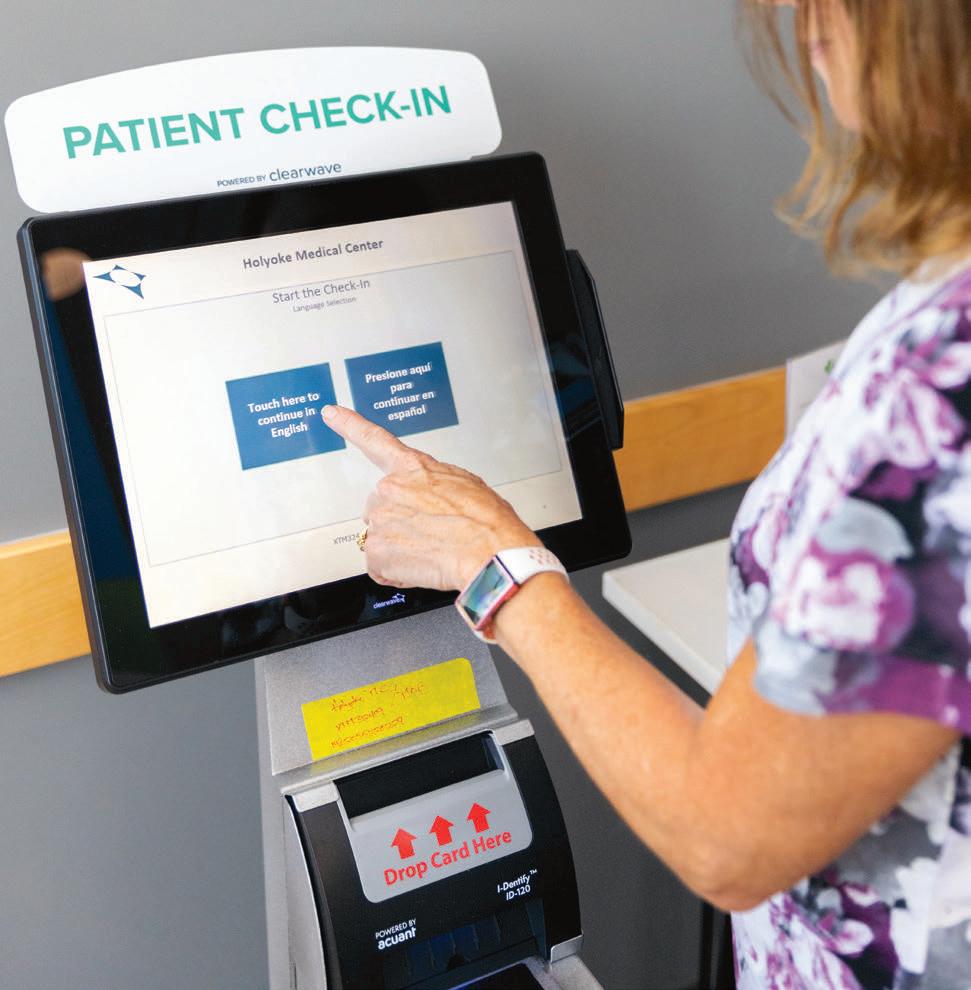
WHEN A DOCTOR HAS SURGERY
An HMC physician gets back-pain relief at the Institute for Minimally Invasive Spine Surgery at HMC.
10
12
14
15
BREATHING EASIER IN WESTFIELD Pulmonology services branch out to a new location.
INTEGRATED HEALTHCARE FOR ALL Expanded mental and behavioral health services help underserved clients.
COLORECTAL CANCER: ARE YOU AT RISK? Take this quiz to find out when and why you should be screened.
THE PEERLESS PEAR This fall favorite is low in calories, high in fiber and full of both nutrients and flavor.
On the Cover: Frederik Pennings, MD, operates at the Institute for Minimally Invasive Spine Surgery at Holyoke Medical Center using technologies that allow many procedures to be done on an outpatient basis.
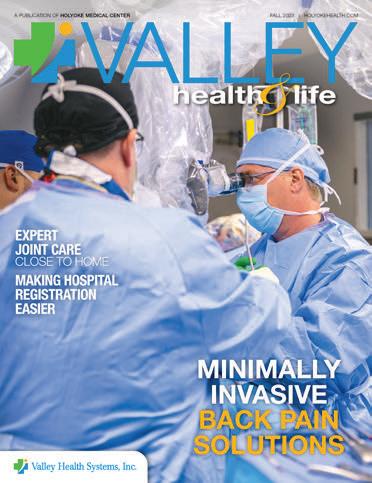
●
To be added or removed from our mailing list, please call 413.534.2789
Breast cancer patients who were active during chemotherapy were less likely than sedentary patients to experience the cognitive side effects of their treatment.
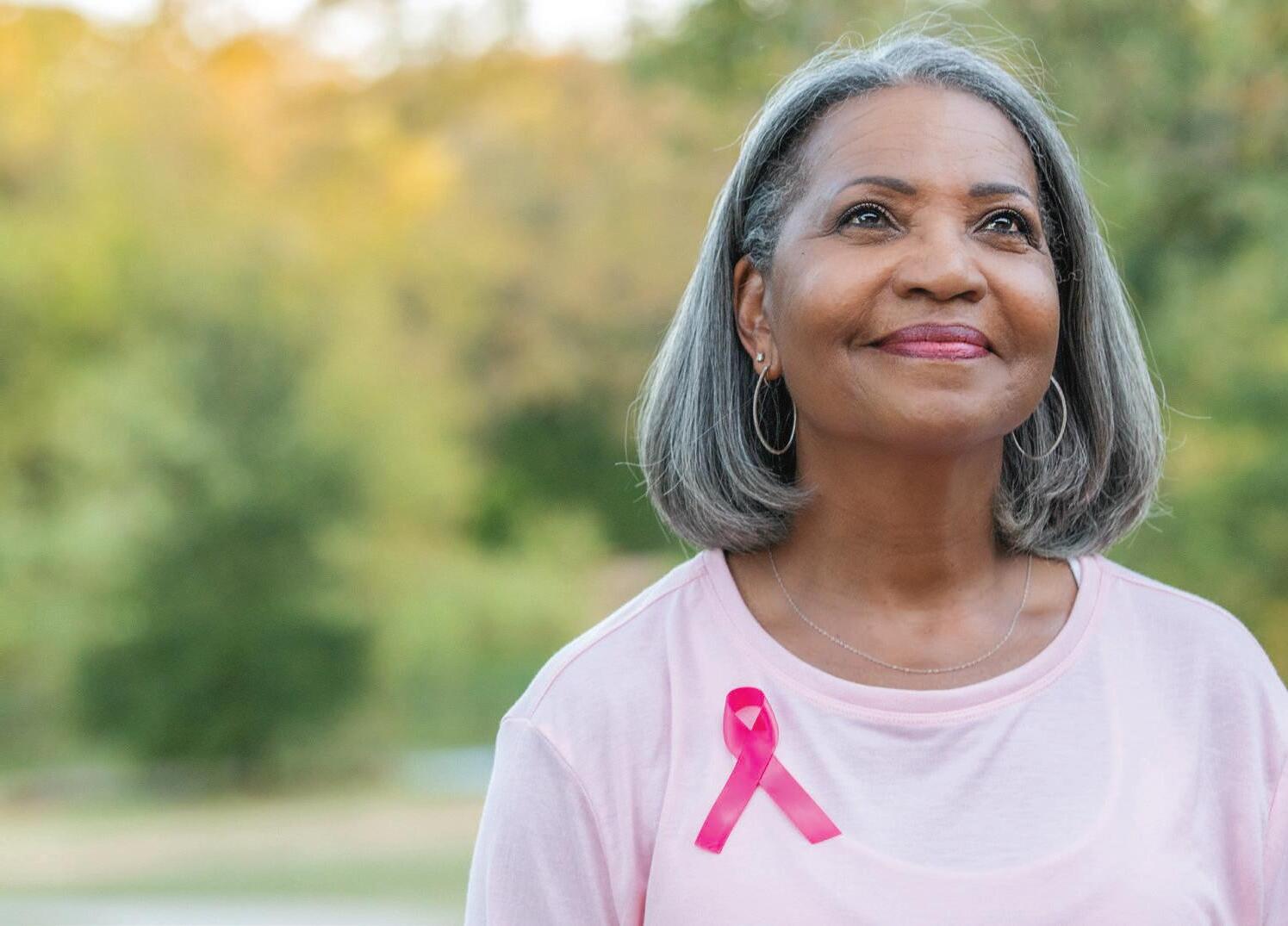
—Journal of Clinical Oncology
People who eat most of their calories at dinner versus lunch were twice as likely to be obese, according to an Italian study. Buon appetito (but at noon)!

—PLOS One

It’s better to use paper towels than air dryers in public restrooms. Reason: Dryers— especially high-pressure jet dryers—can spread airborne bacteria. One study found that bacterial counts were 27 times higher when air dryers were used.

—Journal of Hospital Infection
improves people’s sense of well-being for up to eight hours.
—Scientific Reports
20.8
The percentage of U.S. adults who experienced a mental illness from 2019 to 2020. Mental Health America
People eating the most nitrites—compounds added to processed foods such as bacon, hot dogs and deli meats to extend shelf life—have a greater risk of developing Type 2 diabetes compared with those eating the least amount.
—PLOS Medicine

DARYLE RUARK, MD, AND ROSE BERNALLARIOZA, MD, have seen changes and shifts in the practice of medicine over their careers—which has led to appreciate the independent, community-based approach to care at Holyoke Medical Center (HMC) the newest additions to the hospital’s Orthopedic Center.
“Like most types of work, medicine in general has turned to an emphasis on the business side,” says Dr. Ruark, a board-certified orthopedic surgeon who has practiced for more than 20 years.

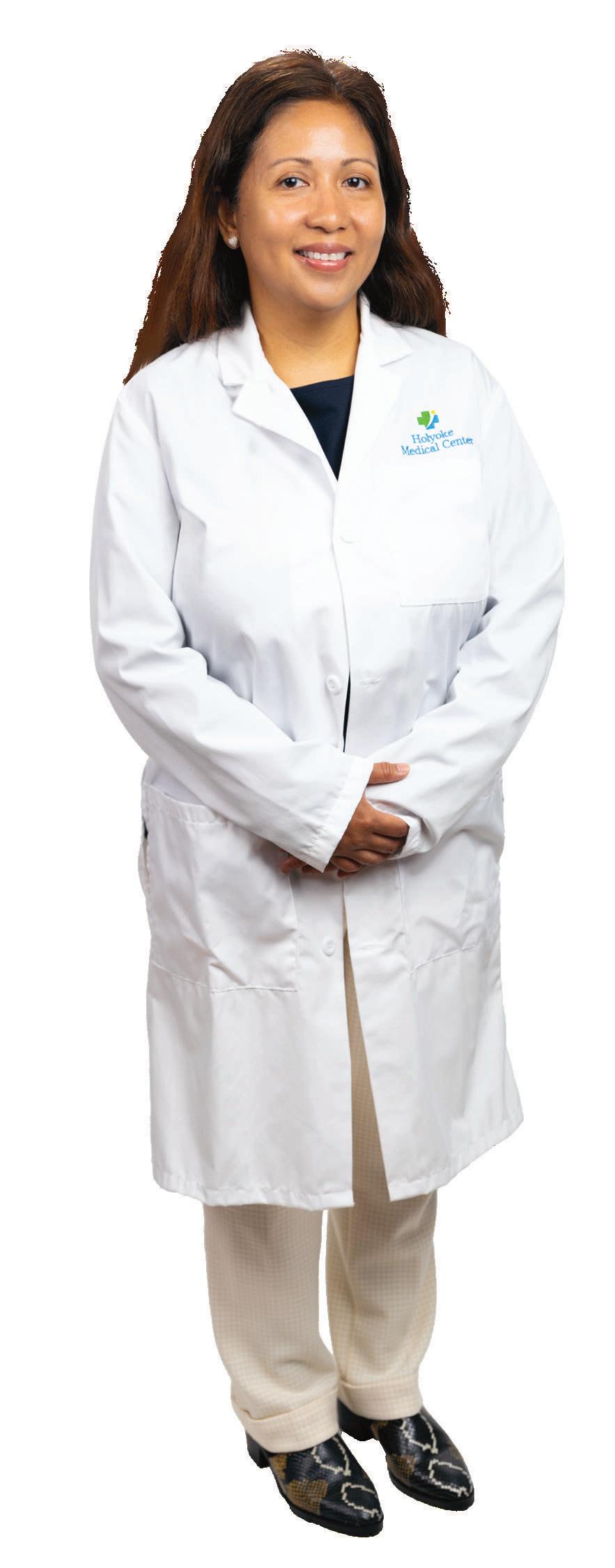
“For example, providers often have many more administrative hoops to jump through than in the past, which can cause less of a focus on patient care.” Ready for a change and a return to a more personalized approach, Dr. Ruark heard from healthcare colleagues who had moved from other facilities to HMC.
“They loved it,” he said. “HMC is not run by a huge corporation based in another state far away. Spend just few minutes on campus and you get that old-school of what medicine used to be like: Providers, staff, patients and families are friendly, relaxed and glad to here. Everyone at the HMC Orthopedic Center has a focus on caring for patients with respect and kindness. are not just a number here.”
The hospital’s distinction as the last remaining independent hospital in Western Massachusetts is important to Dr. Bernal-Larioza as well. “Working community hospital allows me to give back contribute directly to my community,” says Dr. Bernal-Larioza, who has lived and worked in Western Massachusetts for over 15 years. “Joining HMC felt like coming home, like I belong here.”
doctors join a team of Orthopedic Center experts dedicated to restoring movement and reducing pain.
“We start with the simplest, least invasive ways to get people back to a good quality of life and functional
Daryle Ruark, MDlevel through approaches such as physical therapy or activity modifications,” Dr. Ruark says. “If those measures aren’t adequate, we may offer injections and, if all else fails, surgical interventions.” Dr. Ruark specializes in treating conditions that involve joints of the shoulders, hips and knees, including arthroscopic procedures and joint replacement surgery.
Born in Springfield and raised in Longmeadow, Dr. Ruark earned a bachelor’s degree from Harvard University and his medical degree from Albany Medical College. He completed a general surgery internship and orthopedic surgery residency at Einstein Medical Center in Philadelphia and a fellowship in shoulder surgery at Baylor College of Medicine in Dallas. He has been practicing since 2003 in Massachusetts and Connecticut, and is a member of the American Board of Orthopaedic Surgery and the Alpha Omega Alpha Honor Medical Society.
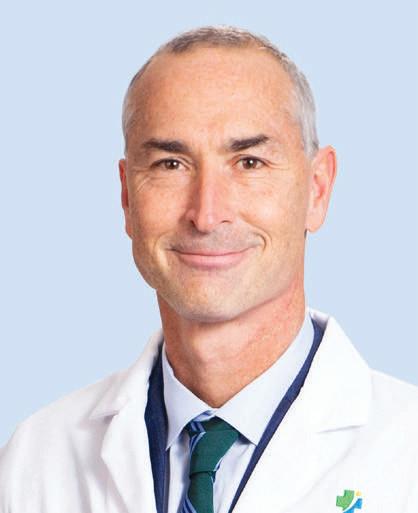
Dr. Bernal-Larioza has consulted with Dr. Ruark about patients over the years, but this is the first time the two have worked together in the same place. As the first physiatrist—a board-certified doctor of physical medicine and rehabilitation—to join the Orthopedic Center, Dr. Bernal-Larioza brings additional perspective to a familiar patient population.
She describes physiatry as a unique yet broad specialty. Physiatrists treat a variety of medical conditions affecting the brain, spinal cord, nerves, bones, joints, ligaments, muscles and tendons. By considering the whole body during an evaluation, physiatrists can often pinpoint problems and enhance function without surgery.
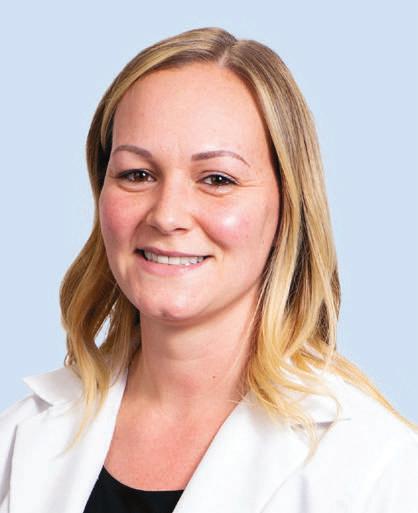
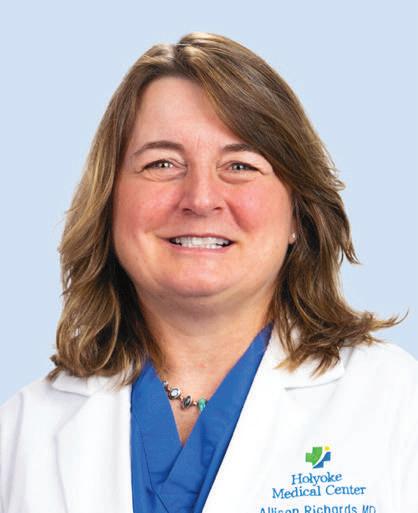
“Physiatry started in the 1930s and was often used for rehabilitation in polio patients and soldiers,” Dr. BernalLarioza says. “It is a separate and distinct specialty from orthopedic surgery and physical therapy, though we often work in tandem. Not all patients need surgery right away, and physiatry can be a good bridge.”
Conservative methods that Dr. Bernal-Larioza may use include not only physical therapy but also occupational and speech therapy, medication management, bracing and, in some cases, injections such as Botox. Boardcertified in electromyography, a diagnostic procedure to assess the function of muscles and nerves, Dr. BernalLarioza conducts tests for people with numbness or pain to diagnose conditions such as carpal tunnel syndrome.
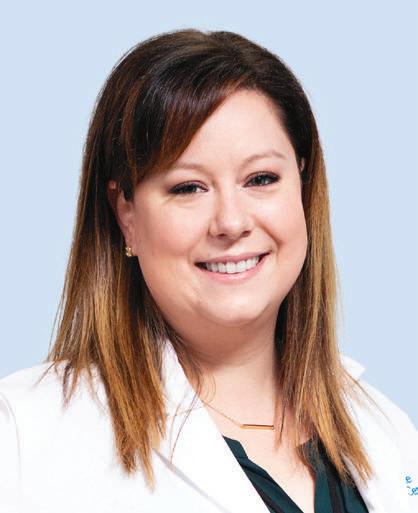
While practicing as a physiatrist in Massachusetts and
Other members of the Holyoke Medical Center Orthopedic Center include:
Connecticut, Dr. Bernal-Larioza also completed a master’s degree in business at the University of Massachusetts Amherst. She holds a bachelor’s degree and medical degree from the University of the Philippines and completed an internal medicine internship and a residency in physical medicine and rehabilitation at Rush University Medical Center in Chicago. A Longmeadow resident with her husband and three children, Dr. Bernal-Larioza—like Dr. Ruark—is excited about working with patients at HMC. “The mission and culture of the organization aligns with our own philosophies of care,” Dr. Ruark says. “We treat all patients the way we would want our own families to be treated.”
HMC Orthopedic Center is located at 10 Hospital Drive, Suite 203, Holyoke. To schedule an appointment with Dr. Ruark or Dr. Bernal-Larioza, call 413.536.5814 .
Noah Epstein, MD Allison Alexander Richards, MD Alicia Hurlburt, PA-C Ta-Mara Meuse, PA-CHOLYOKE MEDICAL CENTER’S NEW HASSLE-FREE CHECK-IN PROCESS IS EASY, SAFE AND SECURE.
Whether you use a device like a smartphone, a computer or a kiosk like this at your provider, HMC’s new check-in process promises to save time and improve patient care.
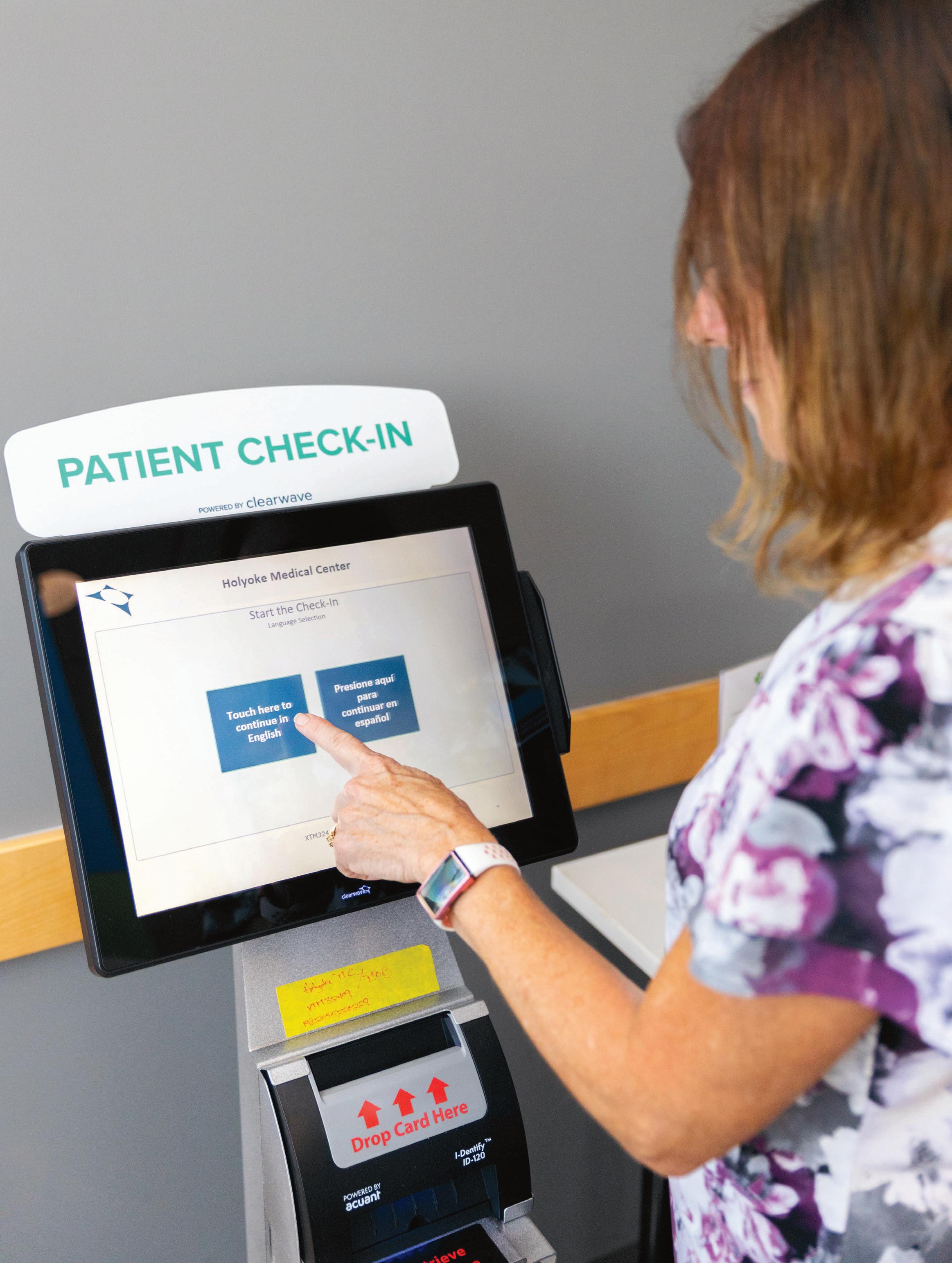
would prefer an easier, more private and more efficient system for checking in, Holyoke Medical Center (HMC) has a new process that you can complete wherever and whenever you want without having to worry about prying eyes or eavesdropping ears—or balancing a clipboard on your knees.
At the core of HMC’s new check-in process, which rolled out in May, is mobile pre-check. “It begins with an appointment reminder message to the patient that comes through text or email a few days in advance,” says Joe Diver, HMC’s Chief Information Officer. “A secure link takes them to the mobile registration.”
While patients are not required to use mobile pre-check, Chief Quality Officer Avadhoot Gokhale encourages them to do so. “It gives them a safe place and ample time to provide their information,” he says. “Patients can complete their registration from their mobile device. If they don’t have one, they can use a computer. If they don’t have a computer, they can use a mobile kiosk at their provider’s office.”
According to Carl Cameron, Chief Operating Officer, “HMC is taking a leadership position to move these types of programs forward in the healthcare industry.”
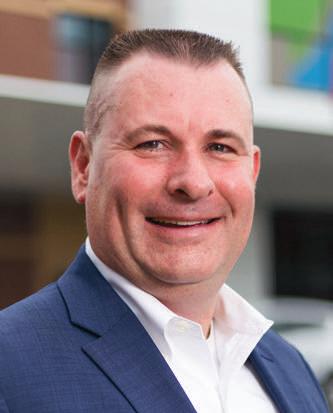
The new process includes questions required by the state regarding race; disability; sexual orientation and gender identity; socioeconomic status; geography; preferred language; and other factors that affect access to healthcare and health outcomes. Questions are asked once each calendar year, though patients can update their answers anytime if their situations change.
Since many people are uncomfortable answering personal questions, it’s important that patients know why
they’re being asked, Diver and Gokhale emphasize.
One-size-fits-all healthcare can lack effectiveness because different people have different needs, and social determinants of health such as income, language/literacy skills and access to nutritious food can affect patients’ needs and the care they receive. “It all ties into health equity,” says Diver. “The more we know about our patients, the better we’re able to provide care and design programs for them.”
“The information that patients provide can help eliminate barriers to quality healthcare because it helps us understand what specific barriers they may be facing,” says Gokhale. “It is also important to make sure that they are comfortable. We want to meet their needs in the way they want.”
Diver says that keeping patients’ information private and protected is a top priority for HMC. “All information shared by patients in the check-in process is protected under all the regulatory requirements of healthcare such as HIPAA [the Health Insurance Portability and Accountability Act of 1996],” he says. “Employees are trained in HIPAA and in how to handle patients’ personal information.”
The new electronic check-in also saves time. “It may take 12 minutes or more to check in the traditional way of going to the desk, filling out forms and bringing them back to the desk,” says Diver. “The new process takes about four minutes the first time you use it. On your next visit, because you’ve already completed most of the process, the average check-in time is one minute, 48 seconds.”
Questions are written at a sixth-grade reading level to ensure they’re easy to understand. “For those who prefer to speak with someone, that process is still available,” Diver says. “We want to make sure everyone is served.”
The new process is deployed in all 19 of HMC’s ambulatory locations. “It’s being used in all primary care and specialty
HEALTH?
Social determinants of health (SDH) are social and economic factors that can influence health equity and health outcomes.
According to the Centers for Disease Control and Prevention, SDH are “the conditions in which people are born, grow, work, live and age, and the wider set of forces and systems shaping the conditions of daily life.” To achieve health equity for all, it’s important to address health disparities related to SDH domains such as:
• Economic stability
• Education access and quality
• Healthcare access and quality
• Neighborhood and built environment
• Social and community context
clinics, and 22,000 patients had used it as of late August,” says Diver. “Toward the end of 2023, it will be introduced into areas such as the emergency department and other locations that are deemed to be a good fit.”
Diver says that the process may be further developed for “recalls.” For instance, he explains, “If a patient is due for a breast screening or an annual wellness visit, we’ll be able to reach out to them through the same technology.”
Gokhale is excited about this prospect. “By reaching out to people about things such as colonoscopies or breast screenings, we can help ensure that related conditions are caught in advance,” he says. “If they can be detected in early stages, it’s less likely that patients will have adverse outcomes.”
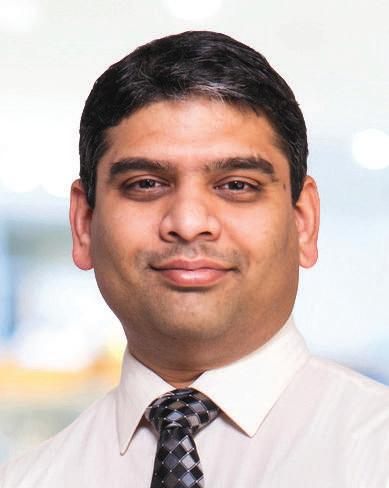
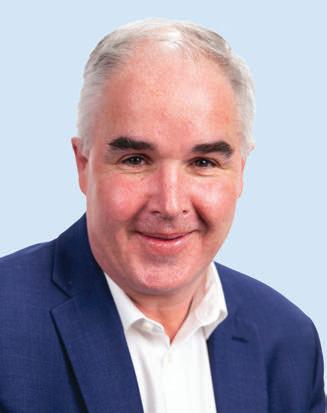
To learn more about our new check-in process, scan this QR code.

AN IMPRESSED PHYSICIAN GETS PAIN RELIEF AT THE INSTITUTE FOR MINIMALLY INVASIVE SPINE SURGERY AT HMC.
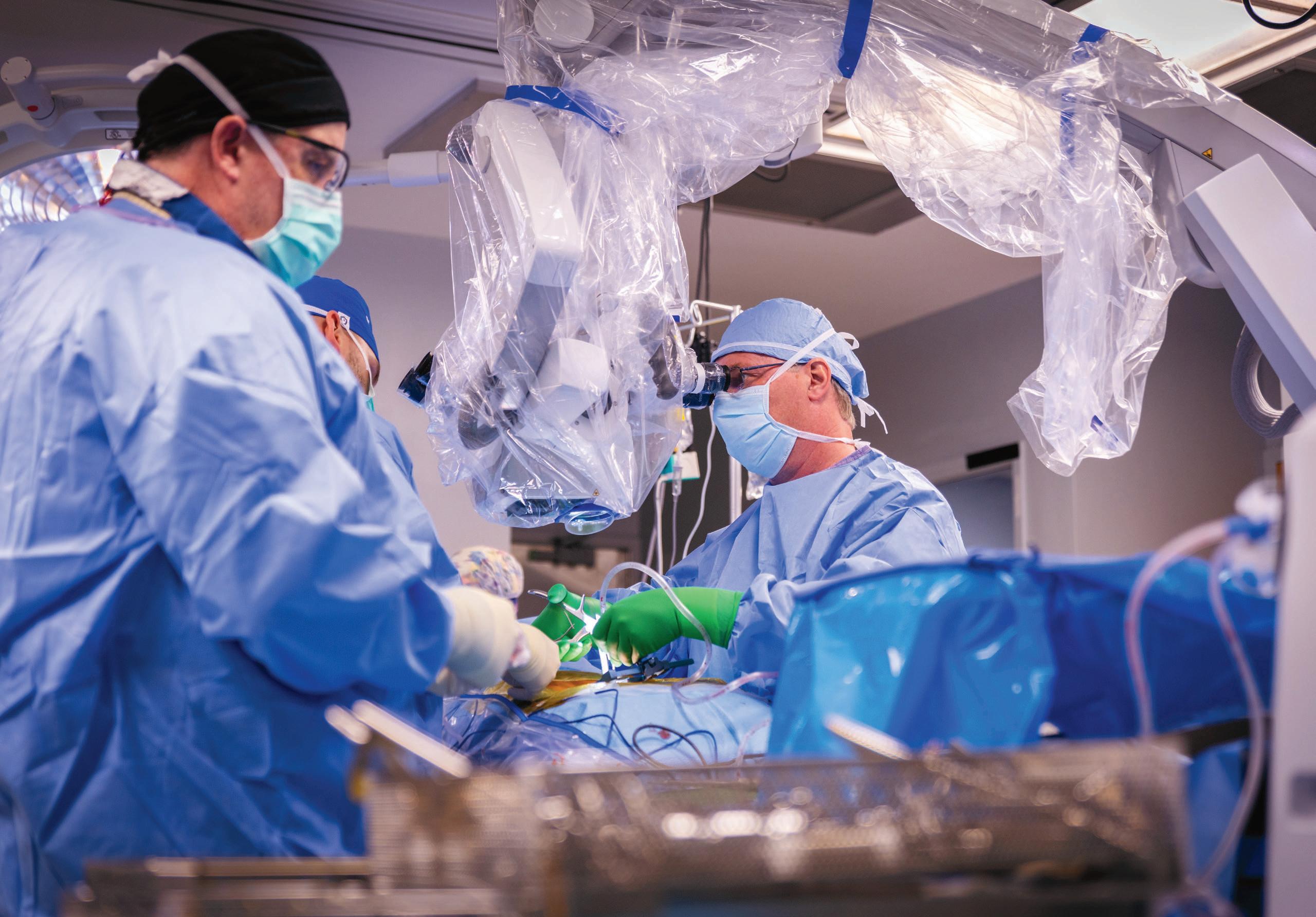
AS A DOCTOR HIMSELF, intensivist and cardiologist Halbert Feinberg, MD, of the Intensive Care Department at Holyoke Medical Center (HMC), can especially appreciate the specialized care he received from an HMC colleague who resolved his
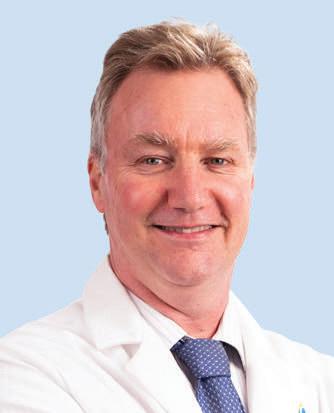
long-standing back pain.
Dr. Feinberg had undergone an open spinal surgery prior to joining HMC, but the procedure had left him with chronic discomfort and a sense that he’d never healed properly.
Bothersome symptoms focused on his right leg. “It was numb on the surface, but the inside felt as if it weighed a thousand pounds,” he says. Leg cramps woke him up three or four times a night and made sleep difficult.
Frederik Pennings, MDAnd he couldn’t sit for more than 10 minutes at a time. “I never had a comfortable day,” he says.
Around the time that an incident made him feel he might have a herniated disc, he discovered that an internationally recognized neurosurgeon, Frederik Pennings, MD, would soon head up HMC’s new Institute for Minimally Invasive Spine Surgery. With more than 25 years of training and experience in neurosurgery, Dr. Pennings is a pioneer in minimally invasive techniques for a range of spinal conditions.
Dr. Feinberg researched Dr. Pennings’ procedures, credentials and success rate, and was impressed. “It was almost serendipitous,” Dr. Feinberg says. “I read his bio, and his approach was appealing to me even before I knew with certainty what was happening with my anatomy.”
Minimally invasive surgery is a less traumatic approach than traditional surgery, with smaller incisions, less trauma to tissues and no general anesthesia. “Most patients recover quicker with less blood loss and lower risk of infection,” Dr. Pennings says. “Many of these surgeries can be performed on an outpatient basis.”
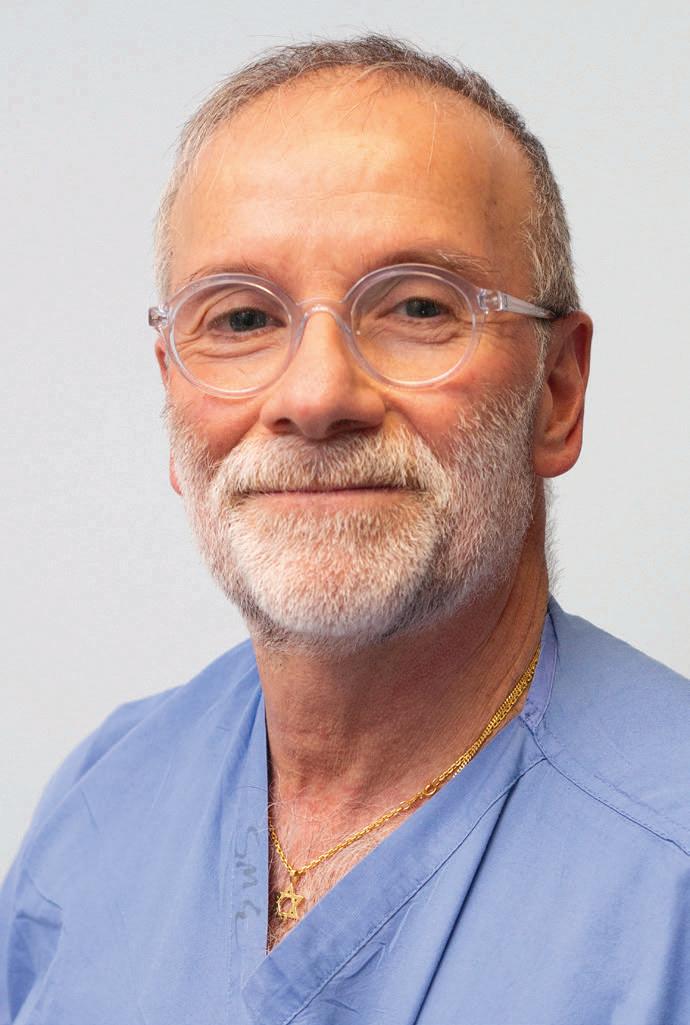
Patients who might not be eligible for an open surgery like the one Dr. Feinberg originally underwent— an hourslong operation with large incisions—due to factors such as age or weight are often candidates for less invasive procedures.
An MRI (magnetic resonance imaging) clarified Dr. Feinberg’s spinal condition. “It was evident that the herniation of a disc at the level above where I’d had my prior surgery had some chronic component to it,” he says. This suggested he probably needed another surgery.
Before Dr. Pennings even arrived at HMC, Dr. Feinberg arranged to
meet with his neurosurgery physician assistant, Michael Bennett, PA-C. “He was very astute and knowledgeable,” Dr. Feinberg says. The two doctors met shortly after Dr. Pennings took on his post at the Institute for Minimally Invasive Spine Surgery, where Dr. Feinberg was one of the first surgical spine cases.
was both clear and serious. “Dr. Pennings told me, ‘It’s not just a matter of needing to have surgery—we’re obligated to do it,’” Dr. Feinberg says.
The professionalism, knowledge and expertise he saw in Dr. Pennings and Bennett reassured Dr. Feinberg. “Dr. Pennings was confident about what he could accomplish,” Dr. Feinberg says. “There was no hedging on his part, and that made me say, ‘Well, let’s go ahead.’ Barely two weeks later, I was on the operating table.”
Dr. Feinberg marveled that the complex procedure was done on an outpatient basis. “I could not have asked for a better experience,” he says.
Active recovery began immediately: A key protocol for the procedure included walking soon after surgery and using alternatives to narcotics for postoperative pain.
“I wasn’t sure how I was going to handle it,” Dr. Feinberg says. “But Dr. Pennings was very reassuring. Not only did my procedure go very smoothly, but so did my recovery afterward.”
By the fourth week after surgery, Dr. Feinberg turned a corner that he hadn’t expected so soon. “I said to my wife, ‘You’re not going to believe this: I can feel my right leg,” Dr. Feinberg says. “It was so remarkable to me.” By five weeks post-op, he felt better than he had in the five years since his original surgery.
“Many people don’t know about these minimally invasive procedures,” Dr. Pennings says. “Hospitals often send patients to certain doctors and don’t always realize what else is out there. At this point, the vast majority of my cases are minimally invasive, and patients come to me from all over.”
Dr. Feinberg can attest to the lifechanging impact of Dr. Pennings’ methods. “When you have suffered with discomfort for so long, I can’t begin to tell you what’s it like to have it disappear. I think he’s five out of five stars.” To learn more about the Institute for Minimally Invasive Spine Surgery, call 413.535.4860 or visit www.HolyokeHealth.com/spine .
After reviewing the interview with Bennett, examining the MRI and understanding the chronic nature of Dr. Feinberg’s pain, the need for surgery
Dr. Pennings was very reassuring. Not only did my procedure go very smoothly, but so did my recovery afterward ... I think he’s five out of five stars
.
- Halbert Feinberg, MD
AS A WESTFIELD NATIVE, Natalie Stucenski, FNP, knows all about the gorgeous landscapes and historic charm of the Pioneer Valley. She has also seen firsthand another side of living in our region: higher incidences of asthma and related environmental allergies due to humid air getting stuck in the Connecticut River Valley.
“Growing up, I knew a number of friends and their family members who suffered from asthma,” she says. “That made me want to learn how to treat it, so I could help my community breathe easier.”
Now, Stucenski will get the opportunity to do just that as Holyoke Medical Center (HMC) extends its highquality pulmonary care to the Westfield
Outpatient Center at 140 Southampton Road. Stucenski, a certified nurse practitioner, will see patients in Westfield, diagnosing and treating illnesses and conditions that affect breathing and the lungs.
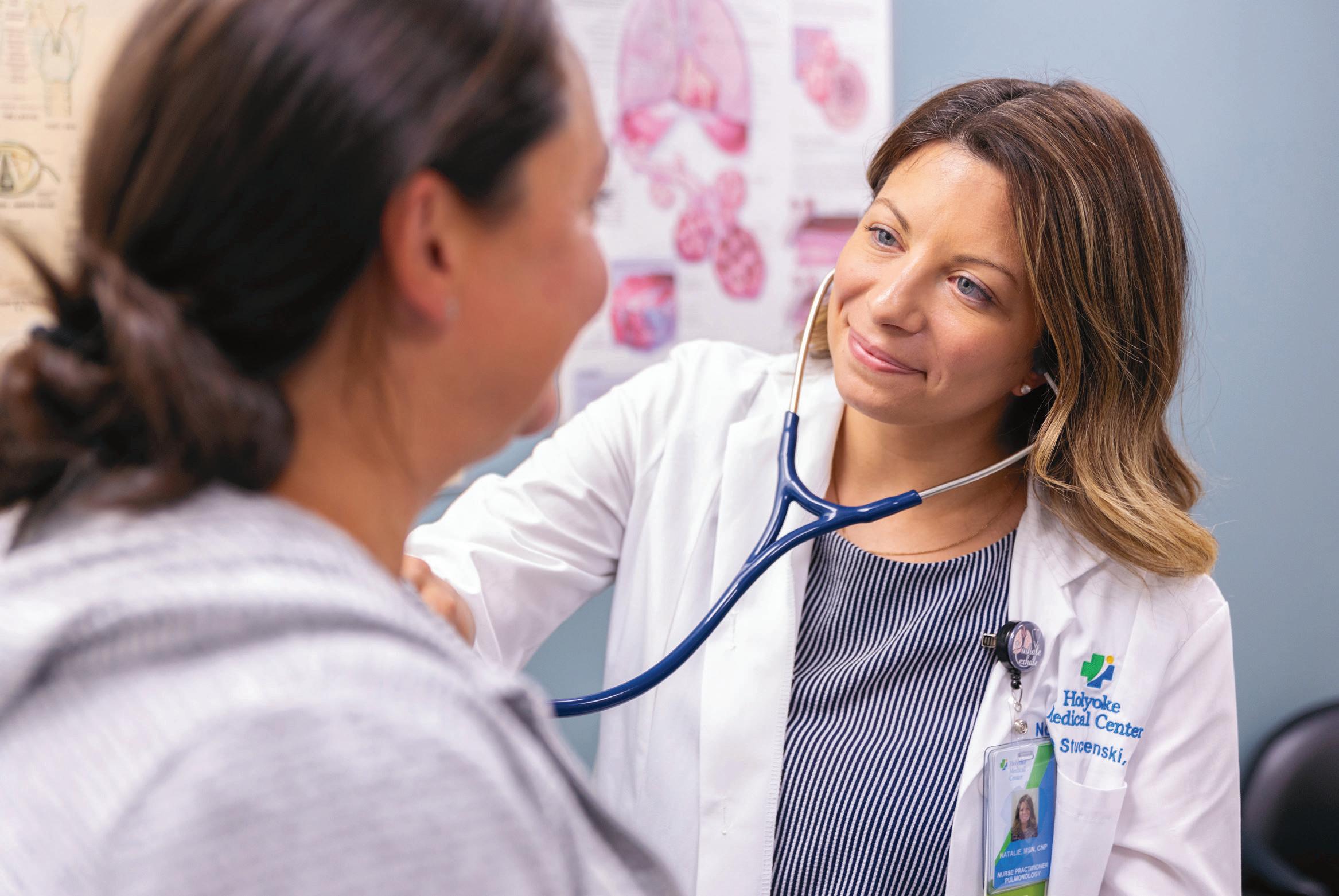
“By bringing pulmonary services to Westfield, we are making high-quality care more convenient for people in that community and within the surrounding areas, such as Russell and Granville,” says Andrey Pavlov, MD, Chief of Pulmonary and Critical Care Medicine at HMC.
“Any lung condition that we can treat at the HMC main campus, we can also treat in Westfield,” adds Stucenski.
“When patients need more extensive pulmonary treatments or imaging, such as computed tomography for lung cancer screening or pulmonary nodules follow-up, or a bronchoscopy with possible endobronchial ultrasound for more direct visualization or biopsies, the resources of the main hospital campus will be seamlessly utilized.”
When it comes to some of the most common lung conditions, proper management is key. “Research shows that regular pulmonary follow-up care improves people’s lung function and enhances their overall quality of life,” Stucenski says. At the Westfield office, patients can get help managing many breathing-related conditions, including:
• Asthma occurs when allergies, air pollution or other irritants enter the airways, causing them to inflame, constrict and/or develop excess mucus congestion. As a result, airways become narrower, making it harder to breathe. Common symptoms include wheezing (a whistling sound when you
breathe), shortness of breath, cough and chest tightness or pain.
• Chronic obstructive pulmonary disease (COPD) is an inflammatory condition resulting from prolonged exposure to smoke (particularly cigarette smoke) that destroys lung tissue and causes airflow blockage with expiration and breathing-related problems. COPD symptoms are similar to those of asthma (the two conditions can mimic each other or overlap) and include a cough that brings up mucus, shortness of breath, chest tightness/ wheezing or recurring lung infections such as bronchitis or pneumonia.
• Bronchitis occurs when an infection or exposure to an irritant causes inflammation of the linings inside the bronchial tubes. Bronchitis can be acute, which means it is self-limited, and usually happens due to a viral infection, or it can be chronic, which means it is ongoing with waxing and waning symptoms. Bronchitis usually manifests itself with a persistent and severe cough—sometimes coughing spells that bring up copious amounts of mucus—along with chest discomfort and shortness of breath.
• Pulmonary fibrosis is a chronic condition, usually with slowly progressing scarring and thickening of lung tissue, which impedes the ability of the lung to absorb oxygen in the bloodstream. Symptoms include insidious shortness of breath that can be associated with dry cough.
• Obstructive sleep apnea occurs when upper airways close momentarily during sleep, causing pauses in breathing (called apneas). Symptoms include loud snoring, breathing pauses or gasping for air during sleep, waking up feeling not well rested and daytime sleepiness.
One of the many benefits patients will get from pulmonary services in Westfield is that the practice is a direct extension of the HMC Pulmonology Center. “Physicians at the main campus will work closely with our Westfield office,” Stucenski says. “We will exchange insights and expertise regularly, including our weekly lung cancer screening meetings, so we can develop personalized and effective treatment plans for each patient.”
Patients will need a referral from their primary care provider to access
The Westfield Outpatient Center at 140 Southampton Road also includes:
• FAMILY MEDICINE
Board-certified expertise that enables continuity of care and comprehensive primary care services for every stage of life, including pediatrics, geriatric care and women’s health. To learn more, call 413.535.4800.
• WALK-IN CARE
For urgent medical issues, such as seasonal allergies; insect bites; cough; diarrhea; acute asthma attacks; back, knee or joint pain; ear infection; fever without a rash; headaches; nausea; pink eye; rash or skin irritation; school physicals; sore throat; sports physicals; or vomiting. Hours may vary due to staffing availability. To confirm walk-in care hours, call 413.540.5065.
• CORE PHYSICAL THERAPY
Skilled therapists treat a wide variety of orthopedic and neurological conditions. You and your therapist will set goals and work together to attain your highest potential. To learn more, call 413.535.4996.
• CONVENIENT LAB DRAW SERVICES
Monday through Friday, 7 a.m. to 1 p.m. To learn more, call 413.535.4895.
• GASTROENTEROLOGY
A full spectrum of gastroenterology services. To learn more, call 413.540.5048.
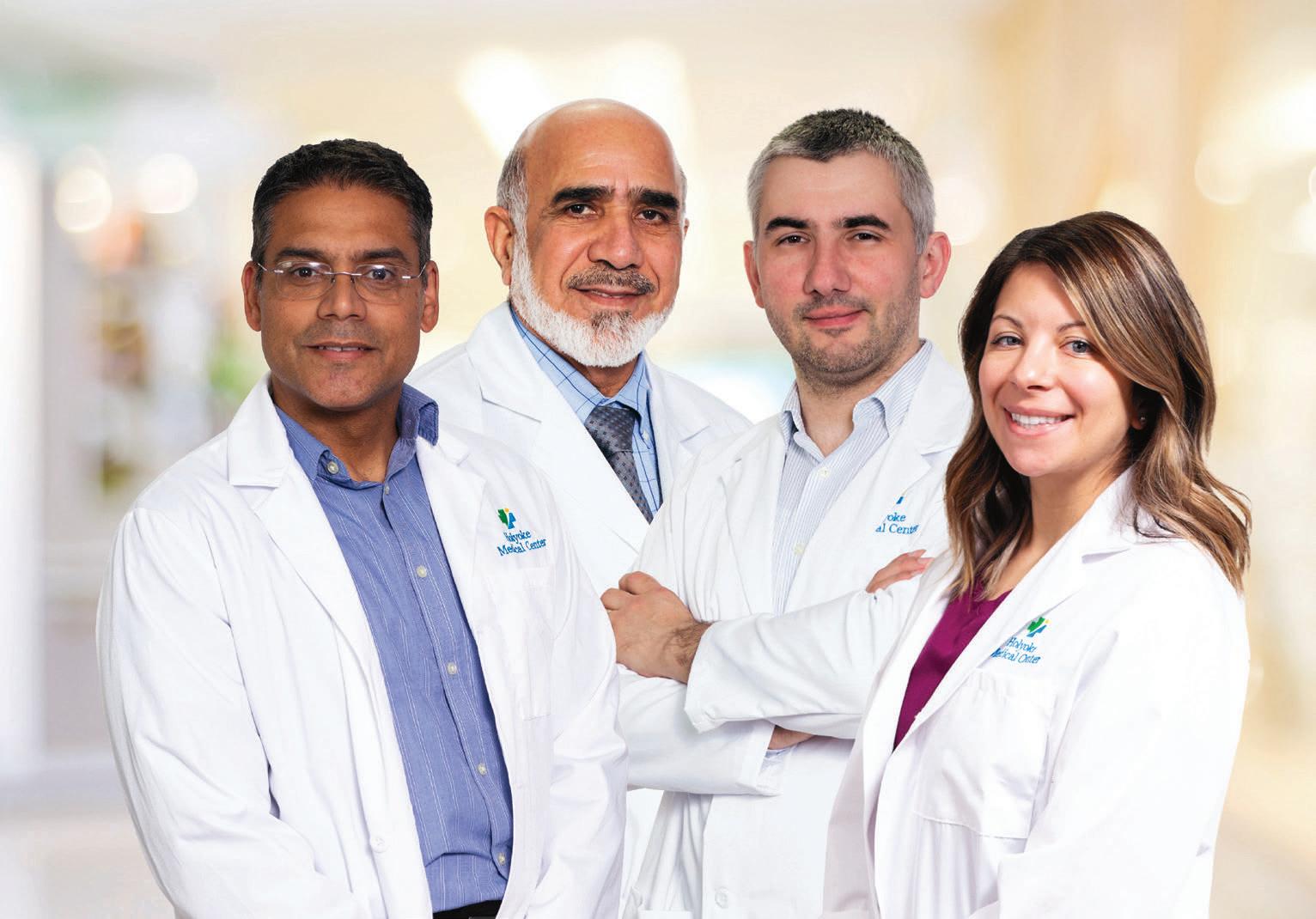
the practice’s services. Once that is in place, they will receive treatment not just from a highly trained nurse practitioner, but also from a longtime neighbor and friend. “I grew up here and live here,” Stucenski says. “It is great that I can provide care for local people and neighbors in the place where I grew up.”
To schedule a pulmonology appointment at the Westfield Outpatient Center, call 413.534.2582 .
DESPITE ONGOING EFFORTS by mental health professionals and years of awareness campaigns and initiatives, mental illness often still bears a stigma—and health disparities can make behavioral health services inaccessible to many.
But that is not the case at the River Valley Counseling Center (RVCC) Certified Community Behavioral Health Clinic (CCBHC), where mental health is considered an important part of overall healthcare and health equity is a priority. Thanks to grants from the federal
Substance Abuse and Mental Health Services Administration and Community Mental Health Centers, both awarded in 2021, RVCC’s CCBHC is able to provide a host of expanded services to underserved adult residents of Hampden County who experience mental illness, behavioral health problems, substance use disorders and co-occurring disorders.
The CCBHC model is designed to ensure access to coordinated, comprehensive behavioral healthcare. All of the more
than 500 CCBHC programs in 46 states must meet certain standards, “but each one’s services vary depending on their grant specifications,” says Amanda Hichborn, LMHC, Director of Westfield Outpatient Services and IHCT [Integrated Healthcare Team] Services for Westfield and Holyoke RVCC.
RVCC provides therapeutic and psychiatric services for adults, and the CCBHC program “offers these services plus case managers, peer recovery coaches and health services, including a nurse and medical assistant,”
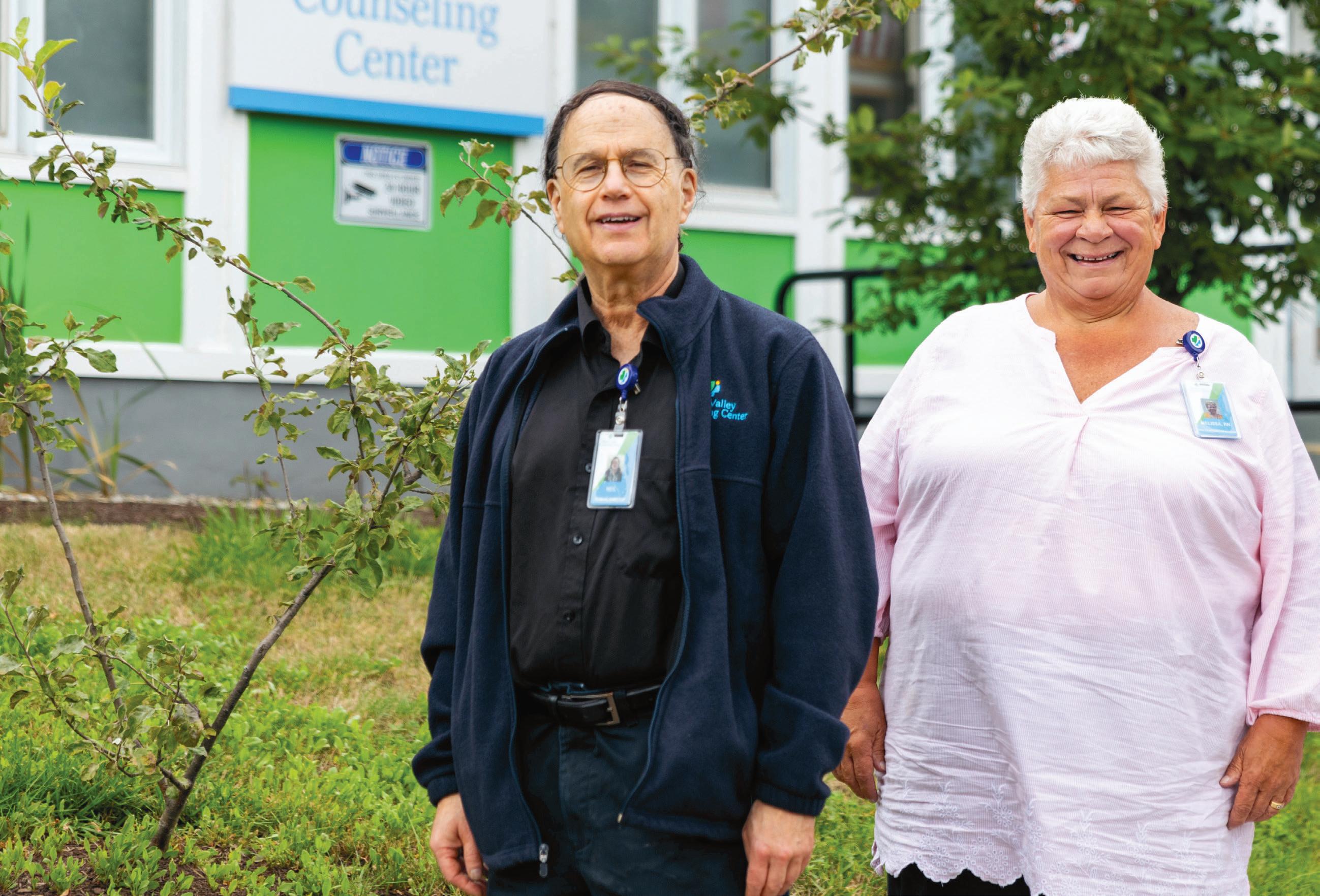
Hichborn says. “This Integrated Healthcare Team works alongside our clinicians to provide a full array of services to grant-funded clients.”
These services can be especially helpful for clients who are underserved for a variety of reasons. “It could be due to disability status, lack of transportation, discrimination, waiting lists or being unable to navigate the application process to receive services,” says Neil Brick, LMHC, RVCC’s Clinical Director, Chicopee CCBHC Program. “Underserved clients also include individuals who are uninsured or underinsured, and case managers assist clients with applying for health insurance in these cases.”
Disparities often prevent access to services by people who need them most. “For example, a person may not be able to access sufficient health services due to
Helping to provide grant-funded integrated mental and behavioral health services are (from left) Neil Brick, LMHC; Melissa Perry, RN; and Amanda Hichborn, LMHC.
poverty and/or lack of knowledge about local resources,” says Hichborn. “These and other disparities may cause increased illnesses and a shortened life span.”
Expanded services provided by RVCC’s CCBHC address disparities and foster health equity by helping clients find primary care providers, specialists and additional resources.
“Prior to the start of the CCBHC program, when a client came to RVCC, at most sites they would receive therapy and psychiatry only,” says Brick. Outside referrals would be needed for clients wanting help with matters such as housing, the Supplemental Nutrition Assistance Program (SNAP), Social Security Disability Insurance, making medical appointments or consulting a peer recovery coach/support person.
“Now, all these services are provided free of charge to all clients who are referred to the CCBHC program,” Brick says. “Clients receiving these expanded services meet weekly with members of the Integrated Healthcare Team for case consultation to ensure coordination of services.” This team model allows the clinician to focus on therapy while other team members work with the client for referrals to a strong network of community support services.
Many clients face housing issues. “They may need to move from their location by the end of the month or may be homeless,” says Hichborn. “Our case managers can help connect clients to low-income housing programs at the local, state or federal levels.” Examples include local housing authorities, the
Not any behavioral health organization can qualify as a Certified Community Behavioral Health Clinic (CCBHC). According to the Substance Abuse and Mental Health Services Administration, CCBHCs are required to serve anyone who requests care for mental health or substance use; meet standards for the range of services provided; act quickly to get people into care; and offer crisis services 24 hours a day, seven days a week. CCBHCs work directly or with collaborating organizations to provide services including:
• Crisis services
• Treatment planning
• Screening, assessment, diagnosis and risk evaluation
• Outpatient mental health and substance use services
• Targeted case management
• Outpatient primary care screening and monitoring
• Community-based mental healthcare for veterans
• Peer, family support and counselor services
• Psychiatric rehabilitation services
Way Finders program or the Residential Assistance for Families in Transition program.
Whatever a client’s needs, RVCC’s CCBHC works in partnership with many local organizations to coordinate services—and expand RVCC’s vision of providing holistic, person-centered care.
For more information on River Valley Counseling Center’s Certified Community Behavioral Health Clinic, contact:
• RVCC Central Intake: 413.540.1234
• Chicopee CCBHC: Neil Brick, LMHC, Clinical Director, brick_neil@holyokehealth.com
• Holyoke CCBHC: Amanda Hichborn, LMHC, Director of Westfield Outpatient Services and IHCT Services for Westfield and Holyoke RVCC, hichborn_amanda@holyokehealth.com
• CCBHC Project Director: Michele Snizek, snizek_michele@holyokehealth.com
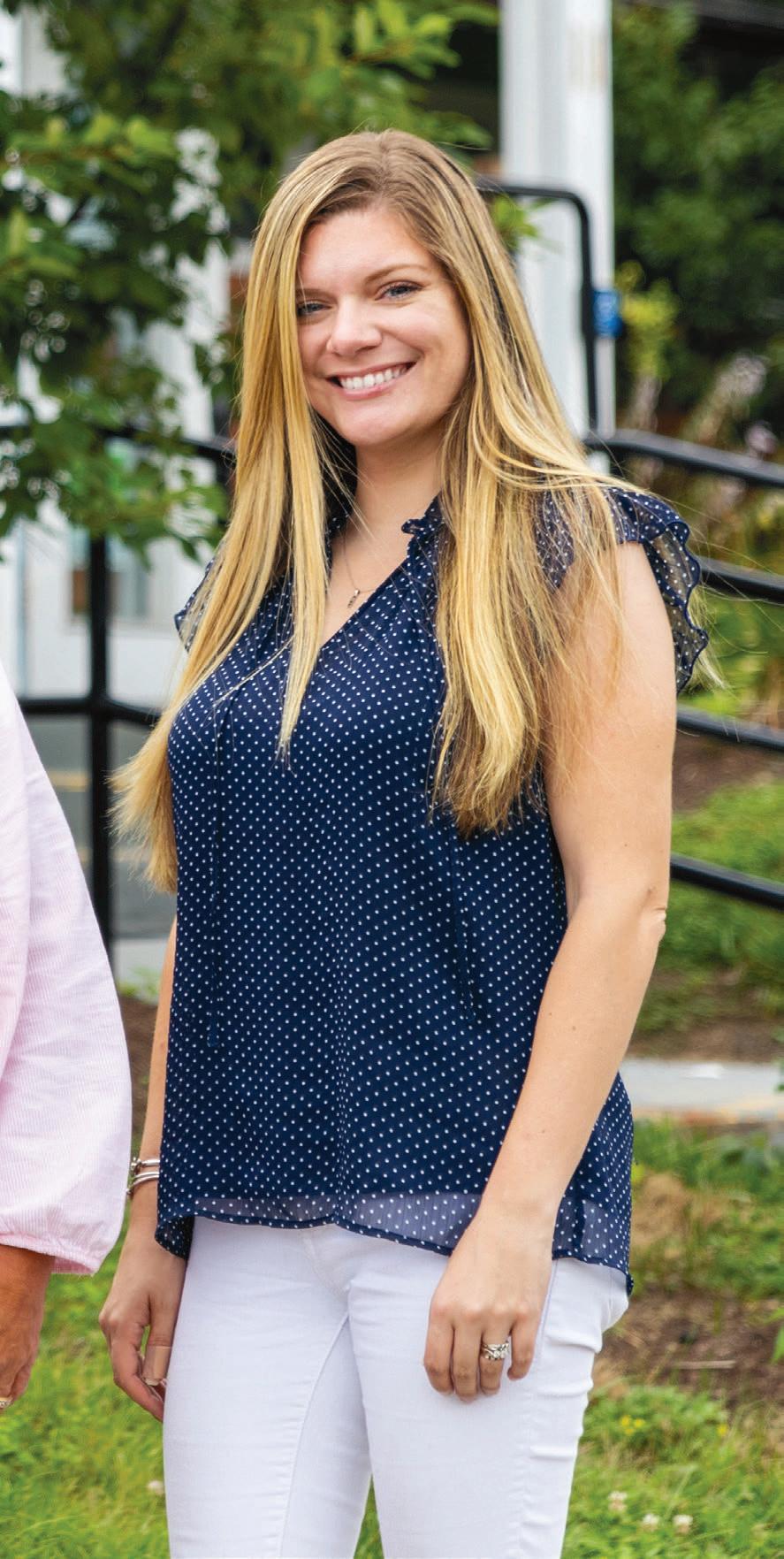
“COLON CANCER IS one of the leading cancers in the United States,” says Tuyyab Hassan, MD, a gastroenterologist with Holyoke Medical Center (HMC) Gastroenterology. That’s one reason why screening to catch cancer or precursor growths early is crucial. Yet many people aren’t aware of the risks or harbor misconceptions about screening. This quiz can help gauge your knowledge.

1. Colon cancer can be prevented.

n T n F
2. Colon cancer often has symptoms.


n T n F
3. Colon cancer can be genetic.

n T n F
4. Colonoscopy is the only screening test.


















n T n F
5. Colonoscopy is a safe procedure.












































n T n F





























1. TRUE. Screening is recommended at 45 years of age for average-risk patients. If polyps—small lumps of precancerous tissue—are found, these can be removed, which reduces the risk of cancer. Cancer can also be prevented by regular physical exercise and a diet that is high in fiber and low in processed meats and fats.
2. FALSE. There may not be any signs of colon cancer until the disease progresses to a critical stage, which is another reason why screening is important. Some symptoms that might occur in some patients include change in stool shape and consistency, change in bowel habits, blood in stools and abdominal pain.
3. TRUE. Colon cancer may be genetic, and there are several different types of cancer syndromes that can be associated with colon cancer, such as Lynch syndrome. These can also be associated with other cancers such as pancreatic cancer and uterine cancer. If there is a family history, you might need a colonoscopy earlier than the recommended screening age of 45. This can be discussed with your primary care provider or a gastroenterologist. You may also need genetic testing.
4. FALSE. Other modalities can also be used such as stool tests and CT scans. However, if these are positive, then a colonoscopy would be the next step for further evaluation.





5. TRUE. Colonoscopy is a very safe procedure, but as with any medical intervention, there is potential for some complications, which may include puncturing the bowel, bleeding and infection. These are extremely rare occurrences in otherwise healthy individuals, and the vast majority of patients go home the same day without any issues.
Colorectal cancer begins in the colon or rectum, both of which are part of the large intestine. In a colonoscopy procedure, doctors use a small, flexible tube with a light and a small video camera on the end to look inside the colon and rectum. The procedure can detect precancerous polyps that may later turn into cancer. Any polyps that are found can be removed during the same procedure.
TO APPRECIATE a food, it’s helpful to imagine if it didn’t exist, so let’s conjure up for a moment a world without pears. Certain Cézanne still lifes would show only an empty plate. We’d all miss out on nutrients, a moistly crunchy texture and a mildly sweet taste. And that wellknown 12-day holiday song would have to end each verse with “and a partridge in an undisclosed location.”
But never fear—the good old pear isn’t going anywhere. (Nor is its homonym-happy name: Pluck two and you’ve got a pair, peel the skin and you’ve begun to pare.) Known for broad bottoms and narrow tops (though some are rounder), the fibrous-centered genus Pyrus grows on trees, but doesn’t ripen well there. (It gets gritty.) Its skin is usually greenish to gold, though some varieties are pinkish—indeed, there are roughly 3,000 known kinds, including Bartlett, Red Bartlett, Red Anjou, Green Anjou, Bosc, Comice, Concorde and Starkrimson.
The cultivation of pears is believed to date back to 5,000 B.C. in China. In those days, so the story goes, a diplomat named Feng Li got so busy tending his pears that he neglected diplomacy. Millennia later, Homer in “Odyssey” called pears “the gift of gods.” You just can’t buy PR like that.
Pears’ benefits to human health are legion. Tipping the calorie scale at a svelte 86, one small fruit (148 grams) can furnish 18 percent of your daily required fiber, 10 percent of your vitamin C, 8 percent of
your vitamin K and 6 percent of your copper. (Yes, you need some copper.) These nutrients’ antioxidant properties can help protect cells from the effects of free radicals, which are molecules that have been associated with the development of cancer.
Like apples but even more so, pears provide the soluble fiber known as pectin, which helps regulate the bacteria in your gut. They can also help ward off cardiovascular disease, for which high blood pressure is a known risk: In a 2019 study, people with metabolic syndrome (a cluster of conditions that together raise the risk of heart disease, stroke and diabetes) who ate a daily pair of pears for 12 weeks experienced small decreases in systolic blood pressure and pulse pressure.
Containing 84 percent water, pears have a natural laxative effect that can help keep you regular. But you never want to pig out on pears all afternoon,
lest gas and bloating result. Medical News Today warns that “people with IBS [irritable bowel syndrome] should speak with a dietitian before including pears in the diet.”

Purchase pears at a grocery or fruit stand, and store them at room temperature until they ripen. (They’re subject to pear-peer pressure—place one in a fruit bowl next to a banana, and that yellow influencer gives off ethylene, prompting the pear to ripen.) Keep ripe pears in the fridge, where they’ll be good for two to three days. You can freeze cooked pears, but not fresh ones, which tend to come apart.
How to tell if a pear is ripe? Apply your thumb gently to the upper portion near the stem; if you feel a slight give, chances are the fruit is ripe and ready. But picking your pear must be paired with your purpose: Plan to cook with the fruit, perhaps to bake, poach or grill?
Think “ABC,” for the Anjous, Bosc and Concorde, firm varieties that hold their shape well. Prefer to chomp on the fruit fresh? Then a juicy Cornice, Starkrimson or Bartlett pear is your best bet.
Pears are often canned (usually Bartlett) or dried, and are sometimes used in jams and jellies. Possibilities for your culinary pear-adise? Cinnamon baked pears, pears with pork chops and onions, pear streusel cakes, pears bordelaise (with wine), pear crumbles (with flour, sugar and oats), pear and blue cheese crostini, pear oatmeal muffins and pear upsidedown cake!